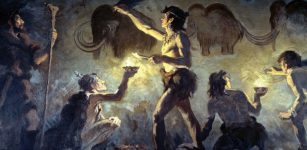Few Witches Were Executed In Wales In The Middle Ages – Why?
AncientPages.com – The fear of witchcraft sparked a wave of persecution and executions across Europe, a historical fact that underscores the intensity of these fears. In England alone, there were around 500 executions, while Scotland saw between 3,000 and 4,000 killings. However, it's noteworthy that in Wales only five individuals were hanged for witchcraft.
This stark contrast highlights how deeply rooted cultural differences influenced the severity of witch hunts across regions.
Diorama of a cunning woman or wise woman in the Museum of Witchcraft and Magic, Boscastle, Cornwall. Image credit: Ethan Doyle White - CC BY-SA 4.0
Early modern Wales was unique in its outlook on witchcraft. Distinct elements of Welsh culture, including superstition and religion, halted the witch trials seen across the rest of Britain and Europe.
In fact, the witch is steeped in Welsh culture. There is speculation among some researchers that the traditional tall, black hat of the Welsh woman served as inspiration for the wide-brimmed hat of the fairy tale witch. Yet Wales saw no witch hunt. So, what are the reasons behind the lack of prosecutions in Wales?
It’s not that Welsh people had no fear of witchcraft or of supernatural harm – they did. But this fear usually played out in arguments among neighbours and family members, amounting to little more than name-calling.
There were other factors, such as the preference for unreformed religion. And the people’s reliance on wise women and soothsayers who could cure sickness and find missing items, and the ever-present influence of old beggar women, meant witchcraft was less poised to be brought to the attention of the courts. When it did very occasionally come to trial, it was usually dismissed.
Accusations of witchcraft
Welsh court records dating from the 16th century onward are held at the National Library of Wales. We know from those trial records that suspicions and verbal accusations of witchcraft like those seen across the rest of Britain and Europe were common in Wales. They also happened under similar circumstances where accusations often followed an argument, or a request for charity which was denied.
In the records, there are bitter arguments between neighbours and family members. Horses are killed, cattle are bewitched, pigs perish, men and women are injured, there are miscarriages and even murders. Most of the time, when someone was accused of being a witch, they were accused by other people in the community. Their accusers were neighbours, relatives and in many cases, people with financial and personal reasons to make accusations.
For a long time, Wales has been seen by outsiders as a land of magic, superstition and the supernatural. English men and women sometimes travelled into Wales looking for consultations with enchanters and soothsayers.
Women in Wales even looked like witches. They tended to dress in long, heavy woollen skirts, aprons, blouses and large woollen shawls. Most peasant women would have brewed mead and ale. They would have let their community know that there was ale for sale by placing some form of signage outside their cottages. The most popular and well-remembered of these signs was a broomstick.
There are similarities between average Welsh women and the witches written about in early modern literature such as the Malleus Maleficarum, written by a German Catholic clergyman in 1486. These similarities, such as appearance, unreformed religion and tendency to rely on charms and herbs, painted a picture of Wales as a magical land rife with witchcraft. This left juries in early modern Wales in serious doubt about how sensible witch accusations were.
Religion
The people of Wales were not without religion, but they preferred prayer to doctrine. This was perhaps as a result of language barriers. Generally, Welsh people could not read or understand the Bible, which was not fully translated into Welsh until the late 1500s.
Rather than conforming to the Protestant worship indicated by the reformed church, Welsh tradition preferred to worship within the household in ways that mimicked Catholic practices. There is evidence that many people continued to seek the aid of charmers instead of the church. And so Elizabethan and Stuart politicians frequently spoke about the religious “ignorance” in Wales.
The church in Wales also took part in practices some would describe as witchcraft. There was even a strong medieval tradition of cursing by clerics. This sort of formal cursing was often phrased as a petitionary prayer to God, emphasising the overlap between witchcraft and religion in Wales. Parsons were also responsible for writing protective prayers.
It was perhaps for this reason that religious radicals in the south of England saw Wales, as well as Cornwall and the north of England, as “dark corners of the land”. Religious ignorance, superstition and residual Catholicism all contributed to a view of Wales as rife with magic and mystery.
Both charms and curses across Wales contained Christian references and quotations taken from the Bible, showing the overlap between different belief systems. In many Welsh charms and curses, small crosses are written in the margins, indicating the need to perform the symbol of the cross.
A charm shared by Gwen ferch Ellis, the first woman to be hanged for witchcraft in Wales, included the words “Enw'r Tad, y Mab, a’r Ysbryd Duw glân a’r tair Mair” (translated as “the Father, the Son and the Holy Spirit of God, and the three Marys”). Her execution was probably a result of having crossed the wrong people, who had enough influence to sway the assize judges.
Ultimately, there is no one reason that Wales never saw a witch hunt. Wise women, cunning folk and soothsayers were highly regarded in Wales, using “magic” to perform important services for the community. Even clerics were part of this ritual of charming and cursing.
Whether they were brewing, cursing, charming or soothsaying, in Wales, the people accused were rarely doing anything out of the ordinary. While fear of the supernatural was rife among common people, it seems Welsh juries tended to be more concerned with prosecuting theft than witchcraft.
Provided by The Conversation
This article is republished from The Conversation under a Creative Commons license. Read the original article.
More From Ancient Pages
-
 I Ching – The Book of Changes – World’s Oldest Book Of Wisdom Used To Predict Future Events
Featured Stories | Sep 12, 2018
I Ching – The Book of Changes – World’s Oldest Book Of Wisdom Used To Predict Future Events
Featured Stories | Sep 12, 2018 -
 Curse Tablets With Messages To The Gods Of The Underworld Found In 2,500-Year-Old Well
Archaeology | Feb 7, 2020
Curse Tablets With Messages To The Gods Of The Underworld Found In 2,500-Year-Old Well
Archaeology | Feb 7, 2020 -
 World’s First ‘Cash Machine’ Discovered In A Wall Of An Ancient Bakery
Archaeology | Apr 1, 2022
World’s First ‘Cash Machine’ Discovered In A Wall Of An Ancient Bakery
Archaeology | Apr 1, 2022 -
 Strange Ancient Accounts Of Fourth Dimensional Phenomena
Featured Stories | Jun 7, 2018
Strange Ancient Accounts Of Fourth Dimensional Phenomena
Featured Stories | Jun 7, 2018 -
 Roman Empire’s Emerald Mines In The Egyptian Eastern Desert – New Evidence
Archaeology | Mar 2, 2022
Roman Empire’s Emerald Mines In The Egyptian Eastern Desert – New Evidence
Archaeology | Mar 2, 2022 -
 Rare Discovery: Remains Of An Avar Warrior And A Belt Unearthed In Vinkovci, Croatia
Archaeology | May 3, 2020
Rare Discovery: Remains Of An Avar Warrior And A Belt Unearthed In Vinkovci, Croatia
Archaeology | May 3, 2020 -
 Jure Grando – First ‘Real’ Historical Vampire Case Documented
Featured Stories | Jun 16, 2021
Jure Grando – First ‘Real’ Historical Vampire Case Documented
Featured Stories | Jun 16, 2021 -
 Solutrean People: Were First Americans European Stone Age People?
Civilizations | Feb 23, 2018
Solutrean People: Were First Americans European Stone Age People?
Civilizations | Feb 23, 2018 -
 On This Day In History: Universal Declaration Of Human Rights Adopted – On Dec 10, 1948
News | Dec 9, 2016
On This Day In History: Universal Declaration Of Human Rights Adopted – On Dec 10, 1948
News | Dec 9, 2016 -
 Legend Of The Sun And Moon In Cherokee Beliefs
Featured Stories | Jul 9, 2019
Legend Of The Sun And Moon In Cherokee Beliefs
Featured Stories | Jul 9, 2019 -
 Surya: Hindu Sun God Who Illuminates The World, Our Lives And Disperses Darkness, Destroys Diseases, And Enemies
Featured Stories | Dec 1, 2020
Surya: Hindu Sun God Who Illuminates The World, Our Lives And Disperses Darkness, Destroys Diseases, And Enemies
Featured Stories | Dec 1, 2020 -
 On This Day In History: William Of Ockham Secretly Leaves Avignon, Fearing A Death Sentence From Pope – On May 26, 1328
News | May 26, 2016
On This Day In History: William Of Ockham Secretly Leaves Avignon, Fearing A Death Sentence From Pope – On May 26, 1328
News | May 26, 2016 -
 6,500-Year-Old Copper Workshop Unearthed In Negev Desert
Archaeology | Oct 6, 2020
6,500-Year-Old Copper Workshop Unearthed In Negev Desert
Archaeology | Oct 6, 2020 -
 Warming Of North Pacific Helped First Human Migration From Asia To North America
Archaeology | Dec 15, 2020
Warming Of North Pacific Helped First Human Migration From Asia To North America
Archaeology | Dec 15, 2020 -
 On This Day In History: First Public And Free School Opened For Poor Children – On Sep 15, 1616
News | Sep 15, 2016
On This Day In History: First Public And Free School Opened For Poor Children – On Sep 15, 1616
News | Sep 15, 2016 -
 Vikings: Facts And History About The Tough Norse Seafaring People
Ancient History Facts | Mar 13, 2017
Vikings: Facts And History About The Tough Norse Seafaring People
Ancient History Facts | Mar 13, 2017 -
 Neanderthals Lived Much Longer In Gipuzkoa Than Previously Thought
Archaeology | Feb 10, 2023
Neanderthals Lived Much Longer In Gipuzkoa Than Previously Thought
Archaeology | Feb 10, 2023 -
 Ancient Wooden Sculpture Of Queen Ankhesenpepi II Discovered At Saqqara, Egypt
Archaeology | Oct 18, 2017
Ancient Wooden Sculpture Of Queen Ankhesenpepi II Discovered At Saqqara, Egypt
Archaeology | Oct 18, 2017 -
 Tezcatlipoca: Enigmatic Aztec God Who Looked Inside People’s Hearts And Observed Their Deeds On Earth
Aztec Mythology | Jul 22, 2021
Tezcatlipoca: Enigmatic Aztec God Who Looked Inside People’s Hearts And Observed Their Deeds On Earth
Aztec Mythology | Jul 22, 2021 -
 Unsolved Old Cherokee Mystery In The Great Smoky Mountains
Featured Stories | Feb 27, 2024
Unsolved Old Cherokee Mystery In The Great Smoky Mountains
Featured Stories | Feb 27, 2024

